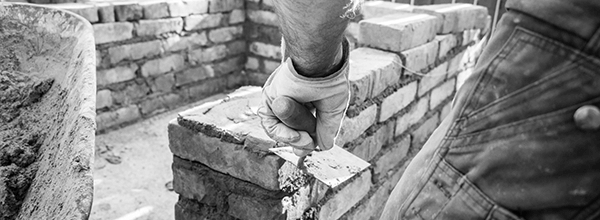Brick and stone masons create magnificent buildings by cementing natural stone or manufactured bricks into place. Unfortunately, this cement often contains asbestos, the only known cause of mesothelioma. This means, unfortunately, that mesothelioma in brick and stone masons is far too common.
Mesothelioma and Brick and Stone Masons Explained
Brick and stone masons are talented craftsmen working with stones or bricks to create buildings and other structures. Masons’ materials are carefully selected to stand the test of time, and hardy and inexpensive materials are always favored.
Asbestos cement was a common ingredient in masons’ mortar. The asbestos made cement more pliable and less likely to crack while providing insulation and fireproofing properties.
The cement used by brick and stone masons in the past often contained up to 10% asbestos.
This material has since been linked to mesothelioma, a cancer that develops after asbestos fibers are inhaled or ingested. The makers of asbestos products, including those used by brick and stone masons, knew of the dangers since at least the 1930s but concealed this information. They continued to make money from asbestos while millions of people were exposed to this deadly carcinogen.
Because of the presence of asbestos in building materials, brick and stone masons were exposed to more asbestos than many others.
Diagnosed with mesothelioma? Call us now at (877) 450-8973 to see if you're eligible for compensation.
History of Brick and Stone Masons Working With Asbestos
Brick and stone masons perform two separate jobs:
- Brick masons, or bricklayers, work with manufactured bricks.
- Stone masons work with other types of natural and manufactured stone.
The cement that holds bricks and stones together is almost as important as the bricks and stones. Cement, as we know it today, has been used since the early 1900s, and asbestos as a cement ingredient came into regular use shortly thereafter.
Asbestos helped prevent cracks and made it easier to create high-quality masonry and was therefore in the powder mixes used by masons.
Opening the bags and mixing the mortar would propel asbestos fibers into the air, where they could be accidentally inhaled.
It wasn’t until the late 1980s that health and safety regulations were imposed prohibiting asbestos from being added to the cement. At this point, asbestos was removed as an ingredient in cement and mortar mixes, but many masons already had years of accidental exposure.
Highest Risk Jobs for Brick and Stone Masons
Brick and stone masons who worked with asbestos-containing mortar are at risk of developing mesothelioma due to their regular exposure. Sadly, a mesothelioma diagnosis often doesn't occur until decades after the initial exposure.
Mesothelioma can go undetected for 10-50 years. In some cases, masons who have long retired from the profession are just being diagnosed with mesothelioma now. While it's been nearly 40 years since asbestos was removed from cement, the long latency period means that masons may be diagnosed with mesothelioma from cement exposure for decades to come.
If you were a brick or stone mason who served in the U.S. military, you may be entitled to assistance and financial compensation. Our Free Veterans Packet can help you understand the benefits you may be missing.
Asbestos Exposure: An Ongoing Concern For Brick & Stone Masons
Asbestos exposure is still a significant concern for brick and stone masons. People working on buildings built before the 1990s may come into direct contact with asbestos and inhale the fibers. Masons who sand, cut, remove, or otherwise disturb the mortar (or other asbestos-containing materials used in buildings) are at risk of asbestos exposure.
Asbestos was used in many building materials from the 1930s to 1980s, including:
- Bricks
- Fireproofing materials
- Flooring tiles
- Insulation
- Mortar
- Roofing tiles
- Wall panels
Any of these materials in older homes and buildings could contain asbestos.
All tradespeople working in older homes must be adequately trained in asbestos management and take all necessary precautions against asbestos exposure. Occupational exposure to asbestos has become less common for many career types, but construction and repair jobs like brick and stone masons still put workers at risk of exposure.
Asbestos Lawsuits for Brick & Stone Masons
People are fighting against the unfair consequences of asbestos exposure. Brick and stone masons who were exposed to asbestos and developed mesothelioma have won lawsuits against the companies responsible.
Many states have imposed strict statutes of limitations to keep their mesothelioma caseloads manageable. It’s common for victims to have only 1-3 years after a mesothelioma diagnosis to file.
It's essential, therefore, to reach out to a mesothelioma lawyer soon after a diagnosis to make sure all options are available to you.
If you were exposed to asbestos as a brick or stone mason working in the U.S. military, you may have VA benefits available as well as legal options. The VA application process can be overwhelming, but our team can streamline your application and make it easy.
Contact us to get started.
FAQs About Mesothelioma in Brick & Stone Masons
Did brick mortar contain asbestos?
Yes. Brick mortar was often made with asbestos-containing cement. When the mortar was mixed, asbestos fibers could be released into the air, putting all nearby workers at risk.
Can asbestos be in stones?
Yes. Although asbestos is much more common in products manufactured before the 1990s, it can occur naturally. Some types of marble, for example, contain very small amounts of naturally-occurring asbestos.
Is asbestos present in cinder blocks?
Yes, asbestos was used in cement formulations of all kinds from the 1930s to the 1980s. Cinder blocks manufactured during this time period were no exception.
Does everyone exposed to asbestos get mesothelioma?
No. While there is no safe level of exposure to asbestos, most people who inhale or ingest this mineral don't develop mesothelioma. Many other factors are believed to play a role, including the amount and duration of exposure, recent radiation treatment, genetics, and many more.
Some individuals develop mesothelioma with only one or a few known exposures to asbestos, but others with a lot of exposure never get sick.


